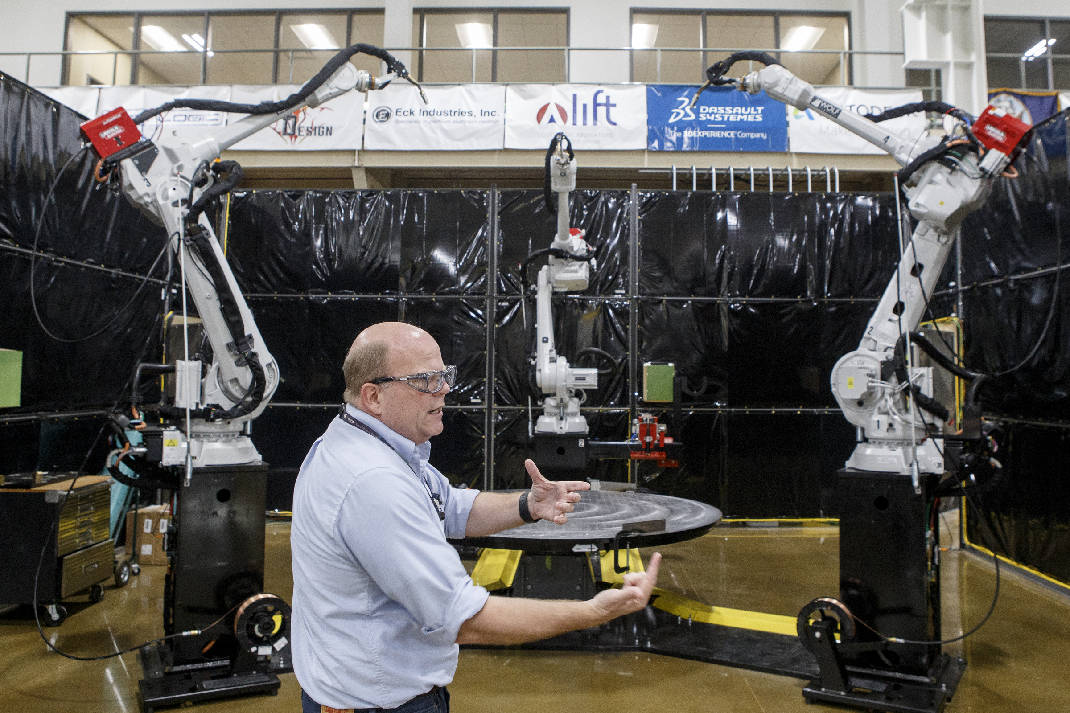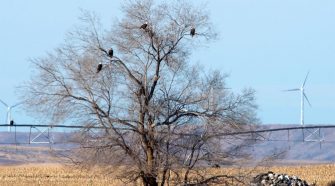America’s oldest and biggest research lab in Oak Ridge has reshaped science around the world and remains a key asset for East Tennessee’s workforce, businesses and economy. This Sunday and next, the Times Free Press looks at some of the work of the Oak Ridge National Laboratory and its impact in our region.
Today: Oak Ridge’s legacy of innovation and its future with the Manufacturing Devolopment Facility.
Next weekend: How Oak Ridge built — and continues to build — the world’s fastest computer with a little help from Chattanooga.
___
KNOXVILLE — In 2015, researchers at the Oak Ridge National Laboratory reproduced a classic 1962 Shelby Cobra by printing the 1,400-pound carbon car in just 24 hours on the Big Area Additive Manufacturing (BAAM) machine, which can manufacture strong, lightweight composite parts without the need for tooling.
When former President Barrack Obama and Vice President Joe Biden saw the car here before its was shipped to the North American Auto Show in Detroit, the president had to hold back his vice president from trying to take the cobra for a spin.
“Biden started pulling out his aviator glasses and we had to explain to him, you don’t get to drive on this trip,” Obama said at the time. “Besides being a cool car, it’s a great example of how a hub like this operates.”
Such additive, or 3D printing, is revolutionizing how and where products are made and assembled. The Manufacturing Demonstration Facility here, which is a part of the Oak Ridge National Laboratory, is playing a key development and testing role for the new production manufacturing technology at a number of companies, including Branch Technology in Chattanooga and its work in additive manufacturing of buildings.
Four years after printing the heralded Cobra model, researchers here have an even more ambitious project they call their Moon shot. Even in a place that first harnessed the power of the atom for military and then peaceful purposes more than a half century ago, it’s an audacious undertaking.
Oak Ridge researchers are trying to use additive manufacturing to print a nuclear reactor, or at least a micro-reactor. The prototype, which lab director Thomas Zacharia has pledged to build within two years, would be about the size of a trash can. But the micro-reactor could offer huge payoffs for America’s nuclear power industry.
Manufacturing Development Facility
Established: 2012
Operator: U.S. Department of Energy’s Advanced Manufacturing Office at the Oak Ridge National Laboratory
Facility: The 110,000-square-foot facility in west Knoxville is capable of binder jetting, 3D tomogrpahy and situ monitoring
Cost sharing: Companies that access the facility are required to make a one-for-one cost match to access ORNL’s facilities and expertise and the lab protects the business partner’s intellectual property rights.
Mission: Performs early-stage research and development to improve energy and material efficiency, productivity and competitiveness for Amercan manfuacturing.
Scope: Over the past seven years, the facility has worked with more than 700 companies.
The lab has a goal of taking the new printed, small reactor critical and producing power within four years to meet the electric demands of about 1,000 homes.
“This is a very aggressive time schedule, but this is what this national lab is known for through its history with nuclear development,” said Lonnie Love, leader of ORNL’s Manufacturing Systems Research group.
Reviving the nuclear option
Kurt Terrani, the technical director for the Transformational Challenge Reactor project, said he hopes the “printed” reactor can pave the way for America to revive the building of nuclear power plants, which has largely stalled over the past three decades due to construction cost overruns.
The Tennessee Valley Authority is the only U.S. utility to complete any new commercial nuclear reactors in the past three decades with the new units it finished at the Watts Bar Nuclear Power Plant in 1996 and in 2017. Southern Nuclear is building two new reactors at Plant Vogtle in Georgia. But, similar to Watts Bar, those new reactors are years behind schedule and are costing billions of dollars more than orginally forecast.
Terrani said additive manufacturing could provide a quicker and more cost-effective method of producing the reactor core for new reactors and, through its customized layered additions, offer a better way to ensure the quality and safety of the reactor components.
“Given the complexity and demanding nature of parts in a reactor core and in a nuclear plant, additive manufacturing allows us to approach component design and production for a specific part completely differently,” Terrani said. “It allows us to significantly reduce the time lines and costs associated with manufacturing complex components. It’s additive, layer-by-layer, production nature can be exploited to monitor the built process and that information can then be used for the certification and qualification of those parts.”
Love said such additive manufacturing was already used at the Manufacturing Demonstration Facility here this year to make the carbon fiber wing tips for Boeing’s777X twin-engine jet. Working with a half dozen companies, the lab developed a process to print the wing tip molds in 30 hours — at a fraction of the normal cost for such molds.
ORNL also worked last year to make carbon-fitted molds for seat backs used by Volkswagen.
“We try to work at the pace of industry and respond to their needs,” Love said while walking through the MDF complex here. “This place is constantly changing with new equipment and new projects.”
Breaking the mold
Most manufacturing is done by reductive machining, which cuts steel or lumber to make and assemble parts. But additive manufacturing uses computer designed molding to make each product from scratch by additive or “printing” like technologies. Such 3-D printing reduces waste and improves both the efficiency and versatility of the production process.
In 2013, the lab developed its Big Area Additive Manufacturing (BAAM) machine, which can print parts 500 to 1,000 times faster than other industrial 3D printers. The BAAM machine received an upgrade after it was used to create the world’s first 3D-printed car in 2014. The “Strati” was designed by Local Motors and developed by ORNL. The car contained just 40 parts and took 44 hours to print.
The Demonstration Manufacturing Facility here has hosted more than 6,000 visitors since it began operation in 2012. The lab works with original equipment manufacturers to use additive manufacturing to make molds, to work with end users and product and also to discover and advance new technologies.
“The best way to transfer technology is working side by side with industry, letting them get their hands on our equipment and see what is possible.” Love said. “By working with hundreds of businesses, we see what industry has needs and what new technologies are needed in the marketplace. Manufacturing provides economic and national security for America and our mission is to be laser focused on helping us lead the world in manufacturing technology.”
Contact Dave Flessner at [email protected] or at 757-6340.


















